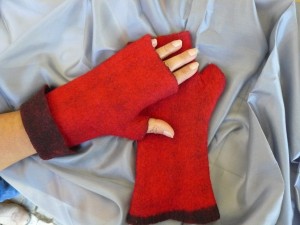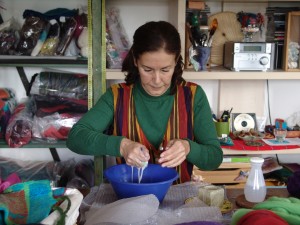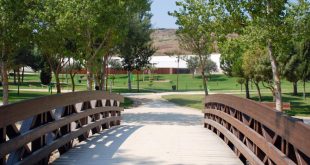
Felt is a 100% natural material made through compacting woollen threads through a rolling method. Whether done manually or industrially, the technique requires the utilisation of rolls to press and aggregate the fibres, forming a cloth without ever really requiring any weaving. This is a truly ancestral form of producing clothing and fashion accessories with the earliest felt remains ever discovered dating back to 600 BC and found in Altai (Mongolia).
To better understand the processes involved, its economic and ecological viability, ECO123 spoke to Maria Custódio, an artist and artisan who turns felt into her form of expression. Based upon this highly versatile and ecological material, she creates useful, exclusive and unique pieces, tailored by her imagination to her client’s purchasing power.
ECO123: What is felt?
Maria Custódio: Firstly, felt is not a cloth like cotton or silk. It is made from sheep wool, which is washed, carded, combed and then dyed. Afterwards, we set about the process of pressing the threads through continually overlaying them until the mould is full, in the meanwhile crossing and dampening with warm water and a little olive soap. We then scrub it away and later roll out the piece and, through this method, we end up shrinking and compacting the felt until it attains its final shape and density.
How did you come across the idea of felt as a form of creativity?
One day, in an international magazine, I came across various works made out of felt. I had never seen clothes and decorations in felt and was quite amazed and immediately felt passionate about the material. I did some research and saw how it was possible to create from such a simple and natural basis. I ordered some wool and began to experiment on my own. Really, I’ve never stopped since. Everything that wool gives us is infinite and impassioning and there are neither borders nor rules – everything is possible.
How do you work with felt and what are the advantages and possibilities?

Felt remains a natural material in every phase of its processing. Right from collecting the wool to dying it, which makes use of vegetal based dyes, there is no need for any waste or pollution.
Working with felt is something a little magical. You cannot simply say “I learned to work with felt and now I know everything”. The material, the wool makes me discover something else new with every different project. What makes felt especially interesting is that there are really no limits. We may make use of it for every type of useful things designed to protect us from the cold, the heat, humidity and noise, whether as clothing, blankets, carpets, decorations, bags… We may turn it into whatever we want.
Are there many felt producers?
Here in Portugal, there are ever more people discovering the material and becoming passionate about it. In the Algarve, there should be more but I do have at least one colleague, Manuela Ortiz de la Torre, who has also been working with felt for many years. I know that there are more dotted around the country but we lack any particular form of interconnection. I did my professional training in the south of France as at the beginning I could not find anybody who would teach me the technique in the way I wanted to learn it.
Would you like to have somebody learning the art with you?
Yes, I would like to be able to spread this useful art. Triggering this interest, this passion that I do feel and would like to share because you end up making useful and attractive things. I see this in my clients, the pleasure I take in making the product is proportional to my clients’ desire to have these objects.
What is the future of this art?
I do think there is a future as I see the interest of people and I think that in demonstrating this simple technique we might foster a new profession in Portugal. It would be a great project to produce something that provides our own self-realisation as well as giving pleasure to other persons.
Return trip from Faro to Monchique: 29,5 kg CO 2 .
 Eco123 Revista da Economia e Ecologia
Eco123 Revista da Economia e Ecologia



